Incorporating Facebook Ads into your digital marketing strategy is a smart decision. As the world’s most popular social network, Facebook has an impressive three billion monthly active users, reaching nearly every demographic worldwide.
Besides, the platform also has an impressive business side that serves millions of different brands, from multi-billion dollar giants to SMBs. Simply put, Facebook Ads is THE place to go if you want to find new customers, establish a connection with existing ones, and scale your business, all with reasonable costs.
However, achieving business objectives is not guaranteed simply by running ads on Facebook without a robust plan. Just like any other marketing effort, Facebook advertising requires a well-thought-out strategy that’s based on sufficient knowledge of the target audience, available resources, and the brand’s customer journey, especially if you own an e-commerce business.
In this article, we’re going to talk about this journey. Better known as a marketing funnel, we’ll walk you through every step you need to take in order to develop an appropriate funnel for your brand and get the most out of your Facebook ads.
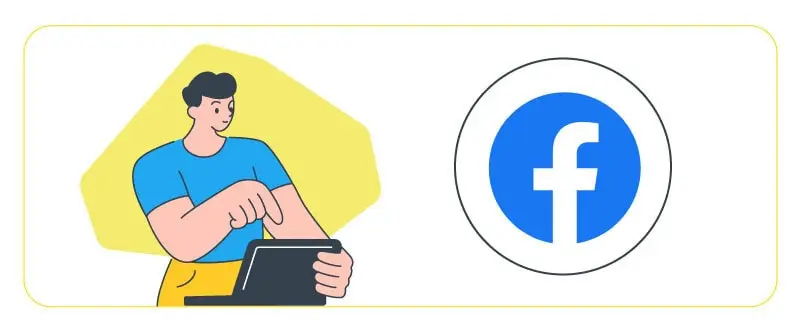
What is a Facebook Ads funnel?
As an e-commerce business, you have different kinds of potential customers. We’re not talking about demographics and characteristics here. Someone who wants to buy from you goes through a journey that leads to that person becoming your customer (and later, brand advocate).
Assuming you’re not starting from scratch, you probably have some customers already that have purchased something from your website. You might have promoted your brand before in different channels. There’s even a chance that some people have heard about you from friends or family. All this creates different audience groups for your brand, each having a level of awareness about you, and each requiring a different plan to lead them all down to the last stage of the buyer’s journey.

This process of driving a complete stranger through a journey with the destination of becoming a customer is called a marketing funnel. It consists of different stages, and at each stage, you need to have use a different tone and provide different value propositions to convince them to go to the next level.
Why is a Facebook Ads funnel important?
Simply jumping into Facebook and running ads without a plan is a big mistake. As an ecommerce business, you know who you’re potential customer is and what it needs. But it doesn’t necessarily work the other way around. Lots of people haven’t even heard about you once. Besides, there are plenty of other similar businesses to you that are advertising on Facebook. How are you going to stand out? Are you going to just shout your name into people’s faces and urge them to buy from you? That’s never going to work.
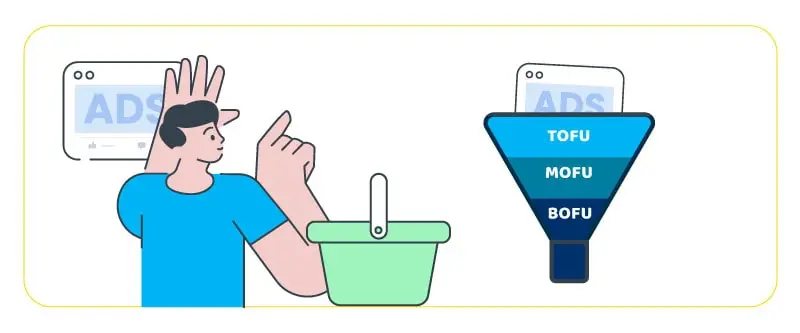
As I mentioned earlier, your audience is already segmented into different groups. Cold audiences have no clue about you, warm audiences are aware of your existence, and existing customers already know about you. You can’t treat them all equally in your ads. You need to introduce yourself to the ones that don’t know you, constantly grab the attention of the ones that are familiar with you to make them interested, and retarget your previous customers with enticing offers for upselling or cross-selling. Without an ecommerce Facebook Ads funnel, this is not possible.
How to create a funnel for your e-commerce ads
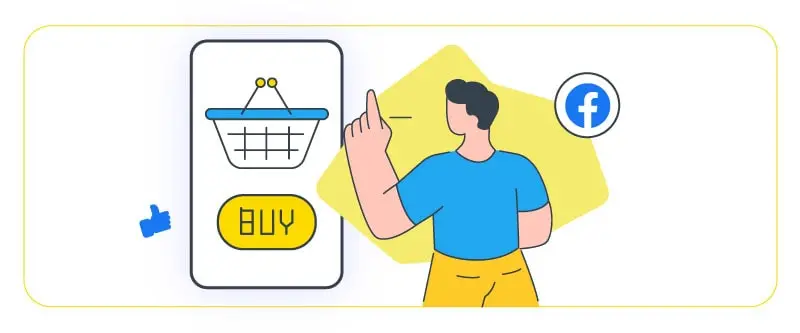
To create a strong marketing funnel, follow these steps:
Set up Facebook Pixel on your outlet first
Proper tracking should be the very first thing on your to-do list. Without reliable data, you basically have nothing to shape an audience with. And by data, we mean your website’s past visitors. Their characteristics, behavior, and activities will help you find out who to target with your ads.

Thankfully, Facebook’s own tracking tool known as Pixel is top-notch. It constantly monitors visitor actions on your website and creates an audience database that you can directly use in targeting. Facebook Pixel removes the guesswork and lets you segment people who have taken specific actions on your store. Later on, you can test these segments and find the best approach to lead them down your funnel. So make sure it’s installed and working.
Create Custom and Lookalike Audience lists
You’re going to need enough knowledge of your core audience to begin. Otherwise, you’ll have to rely too much on guesswork and miss the audience that might actually be interested in you. If you find shaping your core audience difficult, Facebook’s custom and lookalike audiences feature will help you get started.
Custom Audiences lets you connect with the people who, one way or another, have shown interest in your brand. Facebook receives a list of customer data (via uploading an email list or Facebook Pixel) and then matches list items with their profiles and creates a “Custom Audience” list for your ad account.

Lookalike Audiences gives you the ability to create lists of people who share similar characteristics with your current customers and people who have shown interest in your ecommerce business. You can find this feature in the same place as the Custom Audiences in Ads Manager. It’s a terrific way to create lists of cold audiences who don’t know anything about you, but since they look like your warm audiences, there’s a high chance they become interested in your brand.
Facebook gives you the option to select the level of similarity to your current audience on a scale of %1 to %10. The higher you go, the bigger and broader your audience will become. Facebook requires you to assign a source for creating the lists. This source could be a custom audience list, the data collected by Facebook Pixel, or the people who follow your Facebook Page.
Now that you have your audience lists set up, it’s time to create Facebook Ads campaigns for each of your marketing funnel’s stages.
Stage 1: TOFU (Top of the funnel)
The top of the funnel is also known as the “Awareness” stage, where the target audience is a total stranger to your brand and has to be warmed up before moving into the next stage. You could target your Lookalike Audiences with the TOFU campaigns, or go with manually selecting the target audience.
This method is particularly good if you’re starting from ground zero and have no prior core audience list. It’s best to do some customer research first and create a buyer’s persona in order to narrow your campaign’s target audience a bit. Then, in the Facebook Ads Manager, select the demographic, interest, behavior, and location of your targets based on your research.
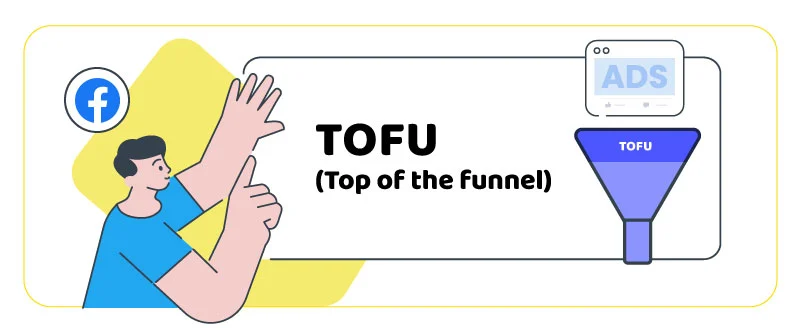
Keep in mind that TOFU campaigns are all about spreading awareness. Your goal here is to grab people’s attention and make a distinct impression. You’re not going for the hard sell and you shouldn’t sound pushy, salesy, and aggressive in your captions, photos, or videos at all. Focus on building trust and showing how your brand could help them solve a problem and what value it brings to their life. Stylish, beautiful photos and videos of your products, a lighter tone, and social proofs are strongly suggested to enhance your awareness campaigns.
Your goal in TOFU campaigns is not conversions, but awareness. So make sure to set website traffic, reach, or views as campaign objectives. Video ads are particularly great for this stage. They have a much higher engagement rate, and they give you enough room to pour some creativity into your ads and send a strong message.
Stage 2: MOFU (Middle of the funnel)
The middle of the funnel, or the consideration stage, is where you focus on collecting leads from prospects. The campaigns of this stage are targeted to people who are somehow familiar with your brand, and now it’s time to make them even more interested and eager to learn more about what you offer and how you could help them fill a need.
Having a proper e-commerce website and highly-focused landing pages is crucial at this stage because one of your primary goals here is to lead prospects to your outlet and motivate them to leave contact info (by filling out a form, subscribing to a newsletter, completing a quiz, etc.).
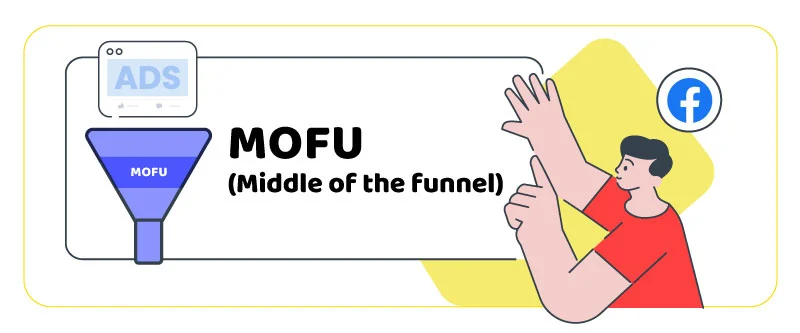
The target audience of consideration campaigns is the people you talked to at the last stage. If you have Facebook Pixel set up on your website, you already have audience lists of people who have engaged with your awareness ads, visited your website, or followed your Facebook Page.
Your tone in consideration campaigns has to be a little more direct. An effective method for collecting leads is to give users the option to leave their contact in exchange for something of value like free trials, special offers, or free guides. For the creatives, it would be nice if you show your products in action or focus on showing how well they could solve a particular problem. You have already boasted about the looks and value. It’s time to emphasize the function.
Make sure to set Lead Generation or traffic as your campaign objective. We recommend using mostly image or album (carousel) ads since they’re more straightforward and don’t take much time to comprehend.
Stage 3: BOFU (Bottom of the funnel)
This is the stage where you turn the leads you’ve collected into customers. Now is the time to get salesy and go for the hard sell. You’ve already made people familiar with your brand and earned their trust to a level. At the bottom of the funnel, you need highly-focused campaigns that excite leads and make them want to purchase your products.
The best move here is to directly target the people who have left their contact info, added products to their carts but never checked out, or viewed specific product pages on your website. As their name suggests, Conversion campaigns have the sole purpose of converting leads to customers, and you can do this in various ways.

One terrific way, thanks to Facebook, is the Dynamic Product Ads feature. With this feature, you can target users with ads of the products they already have shown interest in. For example, if a person has visited a bag’s product page on your website or added it to the cart without checking out, you could target that person with ads containing photos of that bag and remind them of their interest.
Another great approach is to include a strong incentive in your ads, like limited-time offers, discount codes, or free items. Make irresistible offers, focus on amounts saved, and convey a sense of urgency in your ad copy.
Stage 4: Nurturing existing customers
Congratulations! You’ve successfully led a total stranger through your customer journey and turned them into a buyer! But this is not the end. DO NOT neglect your current buyers. They’re the best customers you have! Post-purchase campaigns should be an important part of your ecommerce Facebook advertising strategy.
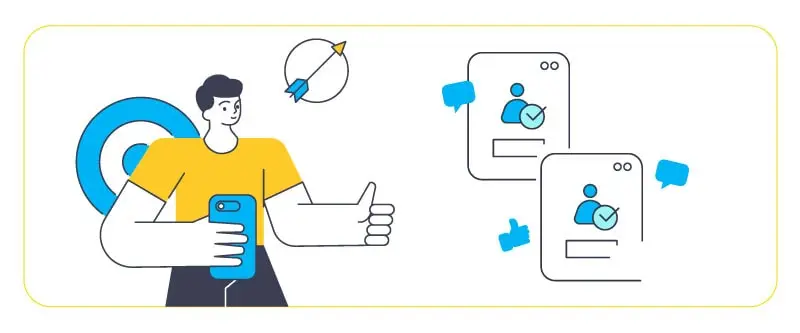
First of all, you must exclude current customers from the audience of your BOFU campaigns. You don’t want to keep reminding someone to buy something they just bought. Instead, target them with ads focused on promoting products related to their past purchases. Another great approach is boosting word of mouth by giving special offers for referrals.
Conclusion
There you go. By following this guide, you’ll be able to create a strong ecommerce Facebook Ads funnel that covers all of your different audience segments. It’s very important to base your Facebook advertising strategy on your funnel to make sure you seize every opportunity to find new customers and keep existing ones to come back.
FAQs
How do I create an ecommerce funnel?
You should start by setting up the Facebook Pixel tracking tool on your website and creating custom and lookalike audience lists. Consider three stages for your funnel: Awareness, which is the stage of introducing your brand to people who have never heard from you and don’t trust you yet. Consideration, where you try to build trust, make people more interested, and collect leads from them. And Conversion, where you go for the sale with exciting incentives and reminding people of the products they’ve shown interest in.
What are the 3 stages of the ecommerce funnel?
Three primary stages of an ecommerce funnel are: Awareness (Top of the funnel or TOFU), Consideration (Middle of the funnel or MOFU), and Conversion (Bottom of the funnel or BOFU).
Which Facebook Ads are most effective for ecommerce?
It’s not like that certain ad types only work for different stages of your advertising funnel. Some of them are good for all stages, like image ads and carousel ads. Video ads work particularly good for awareness ads, and DPA ads are specialized for retargeting hot audiences.
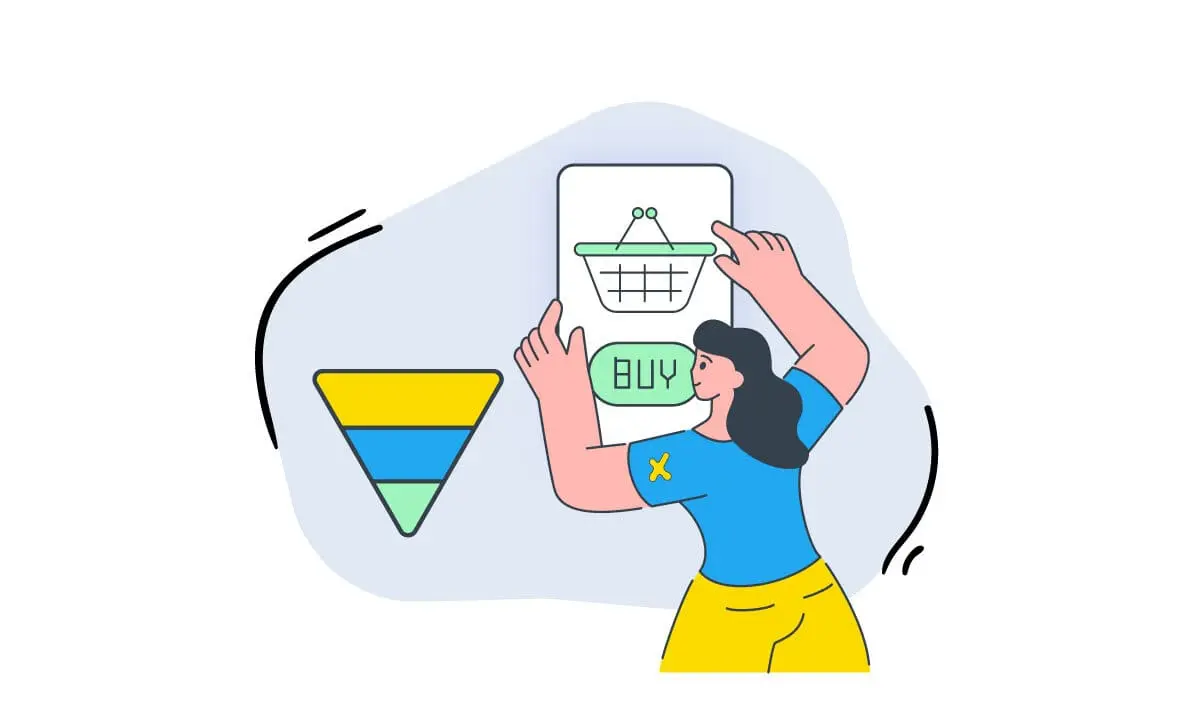

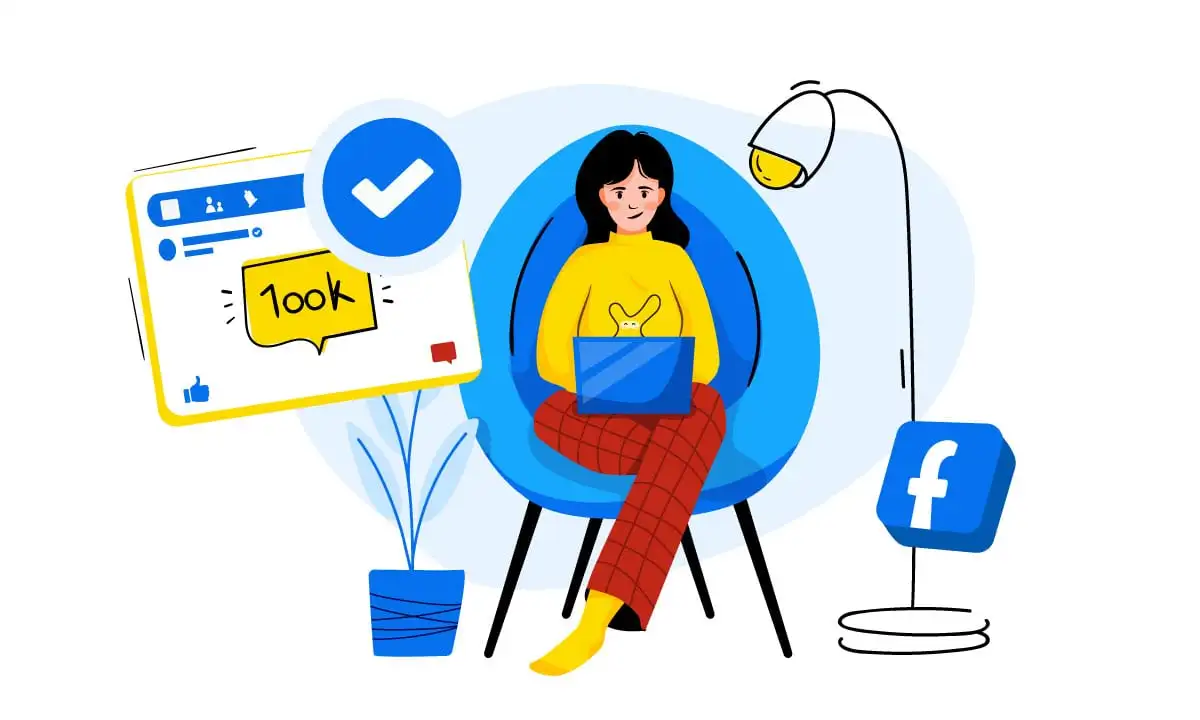
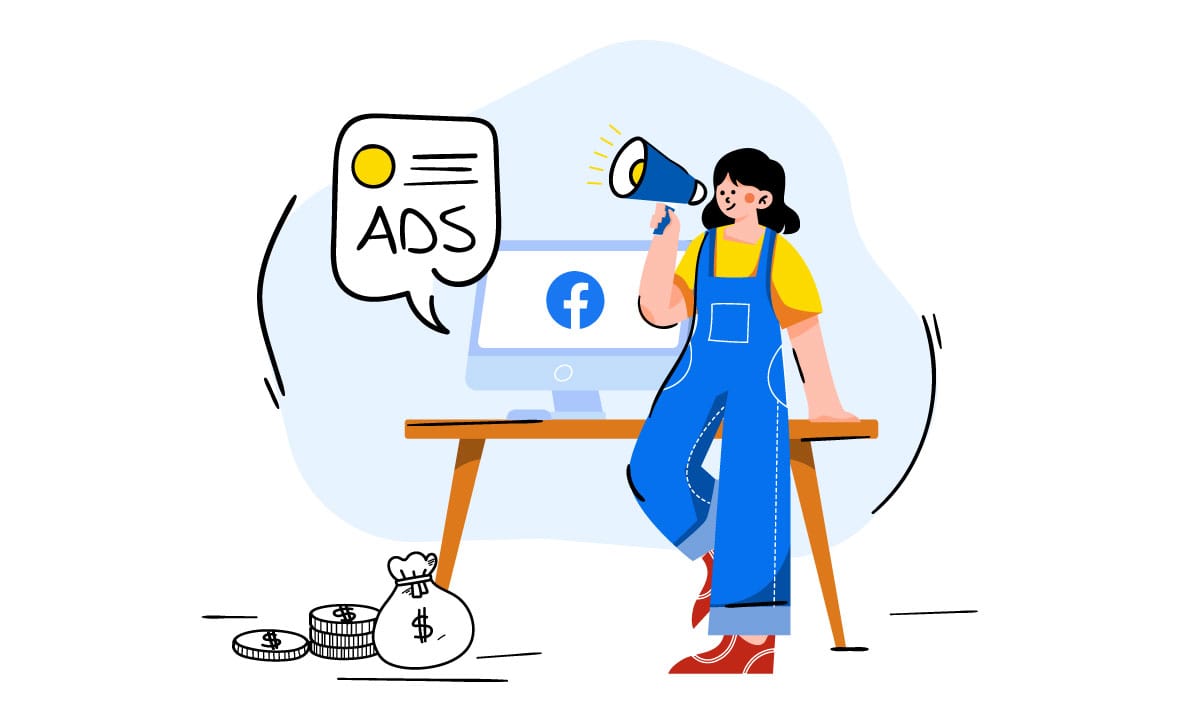
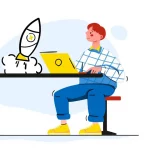

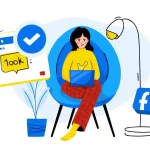
 Facebook Ads Spy Tool
Facebook Ads Spy Tool TikTok Ads Spy Tool
TikTok Ads Spy Tool